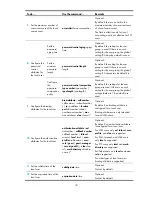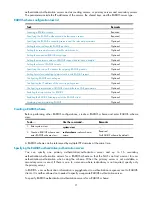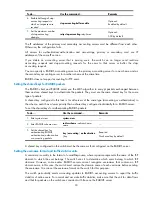
11
Upon receiving a RADIUS packet, a device working as the RADIUS server checks whether the sending
client is under its management. If it is, the RADIUS server verifies the packet validity by using the shared
key and then checks whether there is an account with the username, whether the password is correct,
and whether the user attributes meet the requirements defined on the RADIUS server (for example,
whether the account has expired). Then, the RADIUS server assigns the corresponding authority to the
client if the authentication succeeds, or it denies the client if the authentication fails.
A RADIUS server running the standard RADIUS protocol listens on UDP port 1812 for authentication
requests, but an HP switch listens on UDP port 1645 instead when acting as the RADIUS server. Be sure
to specify 1645 as the authentication port number on the RADIUS client when you use an HP switch as
the RADIUS server.
Protocols and standards
The following protocols and standards are related to AAA, RADIUS, and HWTACACS:
•
RFC 2865,
Remote Authentication Dial In User Service (RADIUS)
•
RFC 2866,
RADIUS Accounting
•
RFC 2867,
RADIUS Accounting Modifications for Tunnel Protocol Support
•
RFC 2868,
RADIUS Attributes for Tunnel Protocol Support
•
RFC 2869,
RADIUS Extensions
•
RFC 1492,
An Access Control Protocol, Sometimes Called TACACS
RADIUS attributes
Commonly used standard RADIUS attributes
Number Attribute
Description
1
User-Name
Name of the user to be authenticated.
2 User-Password
User password for PAP authentication, present only in Access-Request
packets in PAP authentication mode.
3 CHAP-Password
Digest of the user password for CHAP authentication, present only in
Access-Request packets in CHAP authentication mode.
4 NAS-IP-Address
IP address for the server to identify a client. Usually, a client is
identified by the IP address of the access interface on the NAS,
namely, the NAS IP address. This attribute is present in only Access-
Request packets.
5
NAS-Port
Physical port of the NAS that the user accesses.
6 Service-Type
Type of service that the user has requested or type of service to be
provided.
7
Framed-Protocol
Encapsulation protocol for framed access.
8
Framed-IP-Address
IP address assigned to the user.
11
Filter-ID
Name of the filter list.
12 Framed-MTU
MTU for the data link between the user and NAS. For example, with
802.1X EAP authentication, NAS uses this attribute to notify the server
of the MTU for EAP packets to avoid oversized EAP packets.
14
Login-IP-Host
IP address of the NAS interface that the user accesses.
Содержание A5830 Series
Страница 207: ...199 Figure 62 SFTP client interface ...






























